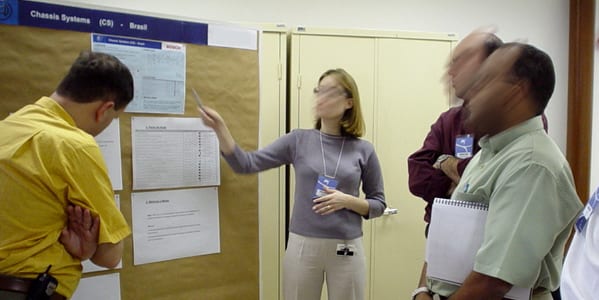
Aligning strategy and process
FEATURE — Ramondin’s Latin American team transformed operations by aligning strategy and daily management through Lean practices, Hoshin Kanri, and A3 problem-solving.
Words: Maria José Cortinez Perrone
When we initiated our lean transformation at Ramondin in Latin America, the company faced a common challenge: a strong team operating without alignment. If you asked my team what our strategy was or where we had to go, everyone gave a different answer. Decision-making was centralized, daily meetings existed without a clear link to strategy, and local teams lacked the autonomy and tools to manage their own performance.
Ramondin is a world leader in capsules for wine, spirits, and other products, operating six plants across the globe. Despite the global nature of our company, our improvement efforts were isolated, disconnected from one another and from the company’s strategic direction.
Our mission quickly became clear: connect strategy, process, and people.
BUILDING THE FRAMEWORK
The transformation began with a bold objective—linking our strategy with the daily running of our processes. The goal was to ensure that everyone, from the shop floor to management, understood the company’s vision and how their work contributed to it.
As we fleshed out a plan, we identified three pillars for our transformation:
- Daily Management: Establishing standard meetings, KPIs, and routines at every level.
- Hoshin Kanri: Translating long-term strategy into actionable objectives and measurable results.
- Problem solving with A3s: Ensuring every improvement effort followed the same structured methodology.
Each pillar reinforced the others. The team created a cascade of aligned KPIs—from strategic indicators to shop-floor metrics—ensuring no duplication but full visibility of progress.
A HUB FOR ALIGNMENT
Initially, Ramondin’s Obeya room—our visual management center—was a closed space tucked away in the plant. It didn’t have a visual impact and it didn’t help our team to stick to the standards. So, we decided to move it to the heart of the factory, between our two main processes. This relocation made a symbolic and practical difference: strategy became visible.
The new Obeya served as the company’s nerve center. Teams held their shift, daily, and weekly meetings there, each with clear rules, standard agendas, and visual performance boards organized by the same five dimensions: Safety, Quality, Delivery, Cost, and People.
The visual connection between strategy and daily work created a “win-win” dynamic—satisfying both people’s needs and business requirements.
STEP BY STEP
The Ramondin Operational System evolved through five structured phases:
- Immersion, development, and training—understanding the current state and equipping teams with tools.
- Collaborative prototyping—co-designing the new management system with operators and leaders.
- Pilot development—testing new routines in one area.
- Factory-wide implementation—rolling out across all departments.
- Expansion and growth—transferring learning to other plants.
By involving teams at every step, we ensured the standards became their standards. That’s why they use them regularly—an incredible change in our company culture.
FROM LATAM TO THE WORLD
It became clear to us that the only way to change the mindset and align people around one way of working is by creating a system. Our new model, initially developed in Argentina and Chile, quickly delivered results—both operational and cultural. Employees demonstrated higher engagement and autonomy, daily management routines became self-sustaining, and leaders shifted from directing to coaching.
Following the success of our pilot in Latin America, I was asked to go to our plant in the USA to replicate the model there. It was great to see that, even during a leadership transition when the Latin American factories operated without a director, the teams continued performing autonomously, guided by the system we had established.
CONTINUOUS LEARNING
In just eight months, with the help of Mauricio Paredes Dondo of Lean Institute Argentina, Ramondin’s Latin American plants transitioned from isolated initiatives to a unified operational model rooted in Lean Thinking. The results—improved performance, engaged teams, and sustained alignment—show what happens when strategy truly meets execution.
Today, we are aiming to expand this model globally. Our next challenge focuses on doubling down on our efforts to develop people. The idea is not to measure who’s capable, but to identify what each person needs to develop and learn in order to give a better contribution to the organization.
When everyone is involved, the culture changes — and results come. Suddenly, success no longer depends on a leader, but is the natural outcome of a shared effort under a solid system.
THE AUTHOR

Read more


FEATURE – What are the immediate signs that tell us that our workplace is not conducive to kaizen? The author draws on his experience as a coach at the gemba to highlight them. Look out for them in your own company!


FEATURE – After Singapore Institute of Technology staff was introduced to lean thinking, a course was launched to provide healthcare workers with the lean skills they need to transform their organizations.


FEATURE – To consistently identify new and better ways of doing things can breathe new life into a lean journey, but only if the knowledge developed can be effectively shared across the organization.


FEATURE – It’s Lean Thinking week and to commemorate the 20th anniversary of the publication of the book, we have asked a few people from the lean community what it meant to them.
Read more


INTERVIEW – As their book on daily management is released in the US in English, we talk to the authors about the thinking behind the book and the lessons learned since its launch in Brazil three years ago.


FEATURE – This Siemens Group-owned medium-sized manufacturer of electrical low-voltage devices has been experimenting with hoshin kanri. In this article, they share their experience and lessons learned.


FEATURE – The author discusses how the hoshin kanri process, coupled with effective coaching, helps us to tackle the challenges inherent to implementing change.


FEATURE - With daily management at the heart of its modus operandi, an organization will be able to quickly identify deviation, start solving problems and make strategy deployment a success.

